A great way to prepare roast duck is Beijing Roast Duck, sometimes referred to as Peking Duck.
It is traditionally served as Peking Duck pancakes, wrapped in Mandarin pancakes along with cucumber and plum or hoisin sauce.
Our recipe is easier than many traditional methods, but still yields a delicious duck, full of classic flavors.
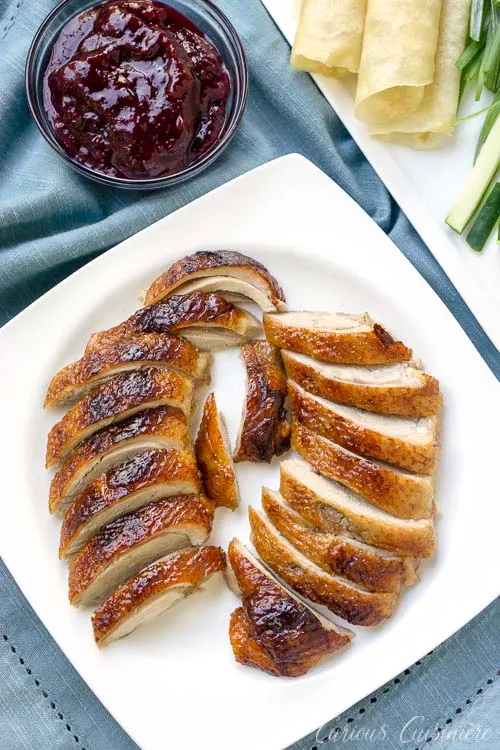
How To Make Traditional Beijing Kaoya – Beijing Roast Duck
When in Beijing, it’s not a turkey or goose that you find, it’s a duck.
And, it’s not just any duck.
Beijing roast duck, also known as Peking Duck or Chinese roast duck, rose to the spotlight over 700 years ago in the royal palace in China.
Making traditional Beijing roast duck involves quite a process, which makes it worthy to be considered the food of royalty.
- First, the chef must pump air between the skin and meat of a whole duck (typically with the head still attached). This separation helps the fat to drain from the duck as it renders, leaving the skin nice and crispy.
- Next, they plunge the duck in boiling water to tighten the skin, which is now loose from the separating.
- Then, the duck is air-dried and brushed with a sugar glaze. (Both aid in getting that coveted crispy Peking duck skin.)
- Finally, the duck is roasted. To roast, it is either hung in the oven or laid on its side and rotated every 30 minutes or so to allow for maximum fat drainage.
This process yields crispy skin, as well as incredibly tender duck meat.
If this process sounds intimidating, read on. We’ve simplified it so that it’s much more manageable in the home kitchen.
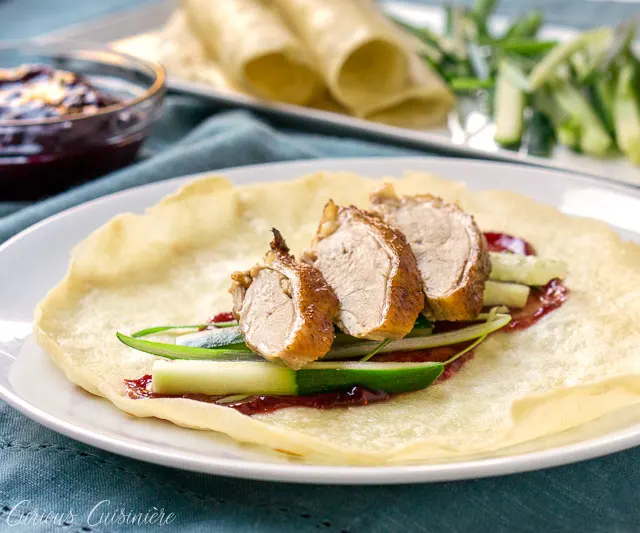 How To Choose A Duck To Roast For Peking Duck
How To Choose A Duck To Roast For Peking Duck
First things first. Let’s pick our duck.
Traditionally the Pekin breed of duck is the best choice for this dish.
Pekin duck meat is tender and it has less fat in the skin, meaning that it will crisp up quite nicely.
That’s good news because the White Pekin duck is the most popular breed of duck raised in the US. It was brought from China to Long Island, so it is sometimes referred to as Long Island Duck.
If you’re in the States and your duck doesn’t say what kind it is, there’s a good bet that it’s Pekin.

Our Pekin duck after air drying in the refrigerator for 18 hours. The skin is visibly dry and taught.Getting Crispy Duck Skin When Roasting Duck
One of the draws of Peking duck is the crispy duck skin.
As you’re working with the duck, you’ll probably notice that the skin is a bit thicker and fattier than chicken skin. So, most of the prep work for roasting Peking duck is for the purpose of getting the skin to render out as much of the fat as it can, so that it will crisp up nicely.
We do this in a couple of ways.
First, we separate the skin from the meat.
Traditionally, air is pumped between the skin and meat to separate it. But, we separate the skin from the meat whenever we make turkey as well, so doing it by hand really isn’t that big of a deal.
Starting at the cavity, slide your hand between the breast meat and the skin, breaking any of the connections.
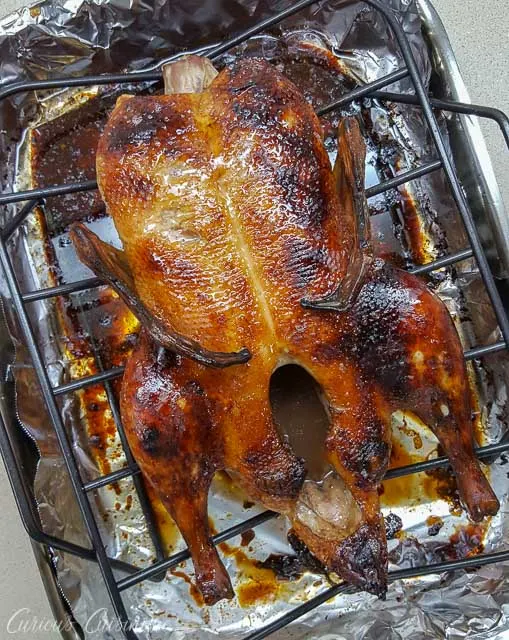
Separating the skin from the meat gives the fat somewhere to easily drain out. If you were simply rendering the duck fat, rather than making Peking duck, you would roast the duck and slash the skin to give the fat somewhere to go.
But, that gives you an end product that looks like it came out of a horror movie.
This way is much more appealing.
The second thing we do to prepare the duck for crispy skin is to dry the duck overnight in the refrigerator.
The dryness of the refrigerator helps pull moisture from the duck skin. You should visibly notice a difference in the skin after 12 hours. (You can even leave it in there for a couple of days.)

How To Slice Roast Duck
Once your duck is roasted, it’s time to carve it!
A duck is more narrow than a chicken, so at first, it can seem a bit tricky to slice.
We find that it’s easiest to simply remove the breast from the carcass. We do this by slicing between the two breasts and around the sides of each.
Then, you can slice between the breast meat and the bone.
Once you get the breast meat off of the carcass, it is much easier to slice thinly for your Peking duck pancakes.
After the breasts are removed, you can remove the legs and thighs by separating them from the carcass at the hip socket with the tip of your knife. These can either be sliced or eaten off the bone.
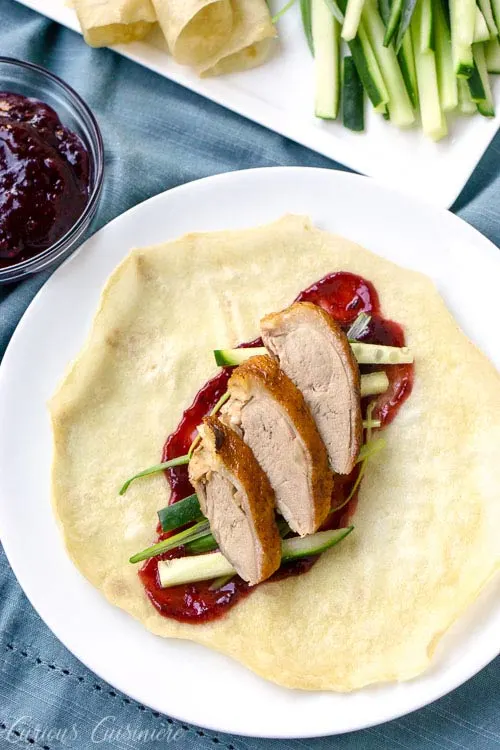
How To Serve Peking Duck Pancakes
Peking Duck is traditionally served with super thin, Mandarin pancakes.
Spread the pancake with plum sauce or hoisin sauce. Add some green onions and maybe a few slices of fresh cucumber.
Then, add your duck slices, roll it up, and enjoy!
Wine Pairing With Peking Duck
DISCLOSURE: We received samples of the Merlot wine mentioned below. As always, all opinions are our own.
Since October is Merlot Month, we’re celebrating #MerlotMe by pairing our Peking Duck with Merlot.
While it might sound surprising, the pairing was quite impressive.

The wine we chose to pair with our duck was Heartcraft Merlot from Ca’Momi.
Ca’Momi was founded in 2006 by three Italians who wanted to honor their roots and bring a sense of the Italian food and wine culture and the everyday celebration of life.
They call their wine Heartcraft. One look at the company and it is easy to see that heart, authenticity, and passion really do run the backbone of all they do.
We found their Napa Valley Merlot bursting with notes of red berries and finishing with a hint of dark chocolate. It had a nice, clean dryness that was balanced incredibly well by the juicy fruit flavors.
As for the pairing, the duck offered just enough fattiness to round out the wine’s tannin, and the red berry notes of the wine paired wonderfully with both the plum sauce and hoisin sauce that we spread on our Peking duck pancakes.
Italy and Napa met Beijing on our table in a wonderfully delightful pairing!
We can’t wait to explore more wines from this winery!
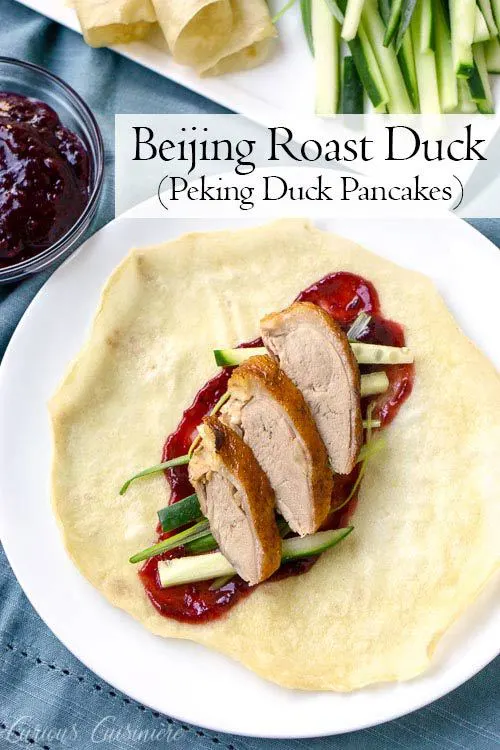
Source: https://www.curiouscuisiniere.com








